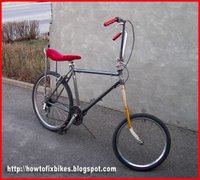

Last summer I recycled a Sylvania LED light puck and a vintage headlight for my cruiser by taken it apart and jamming it in there. It works great and battery life is truly not an issue. I didn't document it because I figured that the puck at $10 was too expensive and the job was just too complicated. That's apart from the fact that it was a real crappy job and by some miracle it is still working to this day.
Then I came across those white LED keychains for $1. Now that's very affordable and they work off of 2 small 3V batteries cells. Now I'm no electrical engineer and what I'm about to present may not be a good set up, proof of the matter is I almost set this thing on fire while building it! So if any of you have additionnal info regarding resistors and such, please feel free to illuminate our lantern and post a comment about it. The pun was totally intended. :)
So here's how I did it. First, take that keychain light apart and retain the white LED. everything else you can toss away. You can keep those 3V cells for another project.
Second, get yourself a 4 AAA battery holder to get the 6 volts required to run that LED, a small switch and some wires. Don't forget the 4 AAA batteries. Wire it all up and make sure it works.
Third, take the bulbs and side connector of the headlight out. The switch screws right into the empty hole left by the connector on the headlight, no need to drill. Lose whatever wiring is left in there. Keep the brass clamps to hold your battery pack in place later.
Fourth, you'll need to plug the upper bulb hole with something shiny like chromed tape so you don't lose any reflective surface. Make a plug out of cardboard or anything else that will press fit the LED in it and the plug into the main bulb hole. If you need to use glue here, do not use superglue, it will fog up your lens and LED for ever. Use white glue, it has a strong bond when dry and it becomes clear when dry. Test everything again, close it up and install on your bike.
Those batteries should last a very long time. Now all you need is an LED red flashing light in the back and you can go night cruising without worrying about losing power to those vital lights. Remember, your main obejective is to be seen. Those white LED's do not go unnoticed, trust me.
Till next time, ride safe and Godspeed.
Gerry





















